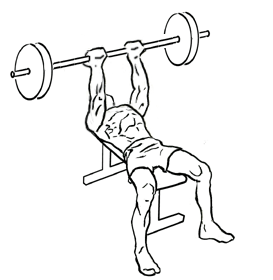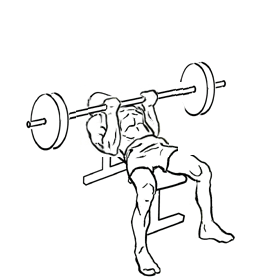Last Updated on September 30, 2014
The Reverse Triceps Bench Press with barbell offers a unique twist on the traditional bench press by isolating the triceps. It’s a fantastic exercise for those looking to add strength and size to their upper arms. Unlike conventional bench presses, this exercise emphasizes the triceps over the chest, making it ideal for bodybuilders, powerlifters, and anyone looking to target their triceps with precision.
In this guide, we’ll cover everything you need to know about the Reverse Triceps Bench Press, from its benefits to detailed step-by-step instructions, common mistakes to avoid, and expert tips for maximizing your results. By the end, you’ll have a comprehensive understanding of how to incorporate this exercise into your routine effectively and safely.
What is the Reverse Triceps Bench Press?
The Reverse Triceps Bench Press is a barbell exercise where the grip is reversed, palms facing the head instead of forward. This subtle change in grip allows for a greater focus on the triceps rather than the chest, particularly the long head of the triceps, which can be challenging to target with other exercises. This exercise is highly beneficial for lifters who want to add size and definition to their triceps and achieve better upper-body symmetry.
Why Choose the Reverse Triceps Bench Press?
There are several reasons to consider adding the Reverse Triceps Bench Press to your workout regimen:
- Targeted Triceps Activation: The reverse grip shifts more of the workload onto your triceps, particularly the long head, which contributes to the bulk of your arm’s back.
- Enhanced Arm Definition: Isolating the triceps can lead to increased definition, giving your arms a more sculpted appearance.
- Variety for Muscle Growth: By switching up your exercises, you’re giving your muscles new challenges, which promotes growth and prevents plateaus.
- Improved Upper-Body Symmetry: This exercise helps balance out the arms’ strength and appearance by focusing on an often underdeveloped area.
How to Perform the Reverse Triceps Bench Press with Barbell
Let’s dive into the mechanics of this exercise. Follow each step carefully to ensure proper form and avoid injury.
- Set Up on the Bench
- Begin by lying flat on a bench. Ensure that your head is at one end, with your feet planted firmly on the floor. This stable base will help you maintain control throughout the movement.
- Grip the Barbell
- Grip the barbell with an underhand, reverse grip, with your palms facing toward your head. Position your hands about 16 inches apart—this width ensures that you target your triceps without straining your wrists or elbows.
- Position the Bar Above Your Chest
- Move the barbell above your chest, ideally positioned around 1 inch below your nipples. This placement keeps the focus on your triceps and away from your shoulders and chest.
- Extend Your Arms Fully
- In a controlled motion, extend your arms straight, pressing the bar upward until they’re fully extended. Avoid locking out your elbows at the top to maintain tension on your triceps.
- Lower the Bar to the Starting Position
- Slowly lower the bar back down to your starting position. Control the descent to maximize muscle engagement and reduce the risk of injury.
- Repeat
- Aim for 8-12 repetitions per set for muscle growth or 15-20 reps for endurance. Adjust the weight and reps based on your goals.
Common Mistakes to Avoid
To get the most out of the Reverse Triceps Bench Press, it’s essential to avoid these common mistakes:
- Using Too Much Weight: Since this exercise isolates the triceps, it doesn’t require as much weight as a traditional bench press. Start with a lighter weight to master the form, then gradually increase.
- Improper Grip Width: Gripping the bar too close can strain your wrists and elbows, while too wide a grip reduces the triceps activation. Aim for a moderate, shoulder-width grip for the best results.
- Locking Out the Elbows: Locking out at the top of the movement can reduce muscle tension and increase joint stress. Keep a slight bend in your elbows at the top to keep the focus on the triceps.
- Rushing Through the Exercise: Performing the exercise too quickly can decrease the effectiveness and increase injury risk. Use a controlled, steady pace to maximize muscle engagement.
Tips for Maximizing Results
Consider these expert tips to enhance your performance and get the most out of this triceps exercise:
- Warm-Up Thoroughly: Since the triceps and elbows are heavily involved, a good warm-up is crucial. Start with lighter weight sets or perform triceps extensions to prime the muscles.
- Focus on the Contraction: As you press the bar upward, concentrate on squeezing the triceps. This mind-muscle connection can significantly impact your results.
- Use Progressive Overload: Increase weight, reps, or sets over time to challenge your muscles and promote growth.
- Incorporate Variations: To keep your triceps training balanced, consider adding other exercises like Skull Crushers or Close-Grip Bench Presses for complete triceps development.
- Rest Properly Between Sets: Allow adequate rest between sets, typically 60-90 seconds, to recover and maintain strength.
Muscles Worked in the Reverse Triceps Bench Press
This exercise primarily targets the following muscles:
- Triceps Brachii: The main muscle worked in this exercise, particularly the long head, responsible for most of the upper arm’s back bulk.
- Anconeus: A small muscle assisting the triceps during elbow extension.
- Forearm Muscles: The grip used in this exercise engages forearm muscles, promoting grip strength and stability.
How to Incorporate the Reverse Triceps Bench Press into Your Routine
The Reverse Triceps Bench Press can be integrated into a variety of workout routines. Here are some ways to make it part of your program:
- Arm Day: Include it in an arm-focused workout alongside biceps and triceps exercises.
- Upper Body Day: Pair it with chest and shoulder exercises for a complete upper-body session.
- Push Day: Combine it with other pressing movements like the shoulder press and chest press.
For muscle growth, aim for 3-4 sets of 8-12 reps. If you’re working on endurance, increase reps to 15-20 with lighter weight.
Variations and Alternatives
To keep your workouts fresh and challenging, consider trying these variations:
- Close-Grip Bench Press: Similar in setup but with a regular grip, emphasizing both chest and triceps.
- Skull Crushers: An isolation exercise specifically targeting the triceps, often used as a finisher.
- Triceps Dips: An excellent bodyweight exercise for triceps, offering variety and requiring minimal equipment.
Safety and Precautions
Like any exercise, it’s important to prioritize safety when performing the Reverse Triceps Bench Press:
- Use a Spotter: If you’re lifting heavy, having a spotter can ensure your safety, especially if you’re new to the exercise or pushing your limits.
- Check Your Equipment: Ensure that your bench is stable and that weights are securely fastened to avoid accidents.
- Listen to Your Body: If you experience joint discomfort or pain, consider reducing the weight or switching to a different triceps exercise. Never push through joint pain, as it can lead to injury.
Reverse Triceps Bench Press Workout Example
Here’s a sample workout that includes the Reverse Triceps Bench Press:
1. Warm-Up
- 5 minutes of light cardio (e.g., jogging or jumping jacks)
- Dynamic stretches focusing on the arms and shoulders
2. Triceps Isolation Circuit
- Reverse Triceps Bench Press: 4 sets of 8-12 reps
- Skull Crushers: 3 sets of 10-15 reps
- Triceps Dips: 3 sets to failure
- Close-Grip Bench Press: 3 sets of 8-12 reps
3. Cool Down
- Light stretching, focusing on the triceps, shoulders, and chest
This workout structure allows you to fully fatigue the triceps and encourage growth by emphasizing multiple angles and exercises.
FAQ: Common Questions About the Reverse Triceps Bench Press
Q: Can beginners try the Reverse Triceps Bench Press?
Yes, beginners can try this exercise with lighter weights to understand the movement. However, mastering the form is crucial before increasing the weight.
Q: How often should I do the Reverse Triceps Bench Press?
Incorporating it once or twice a week in your routine, along with other triceps exercises, is usually sufficient. Too much frequency can lead to overtraining.
Q: Is the Reverse Triceps Bench Press better than traditional bench presses for triceps?
For isolating the triceps, yes. However, the traditional bench press remains an excellent compound movement for overall chest and triceps development.
Q: Can I use dumbbells for this exercise?
Dumbbells can be used for a reverse grip variation, but they require more stability and may not isolate the triceps as effectively as a barbell.
Conclusion
The Reverse Triceps Bench Press is an excellent exercise to isolate and strengthen the triceps, making it a valuable addition to any upper-body or arm-focused workout routine. With consistent effort and the right form, this exercise can help you achieve impressive triceps development, improve arm symmetry, and add variety to your workouts. Remember to start with a manageable weight, focus on the mind-muscle connection, and avoid common mistakes to maximize your results. Add this exercise to your training program, and watch your triceps transform!








